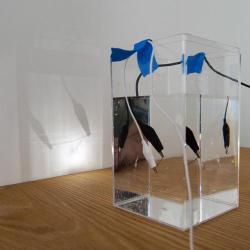Source Institutions
Source Institutions
Add to list Go to activity
Activity link broken? See if it's at the internet archive

In this activity, learners make their own heat waves in an aquarium. Warmer water rising through cooler water creates turbulence effects that bend light, allowing you to project swirling shadows onto a screen. Use this demonstration to show convection currents in water as well as light refraction in a simple, visually appealing way.
- 10 to 30 minutes
- 10 to 30 minutes
- $5 - $10 per group of students
- Ages 8 - 18
- Activity, Demonstration
- English
Quick Guide
Materials List (per group of students)
- One 6- or 12-volt lantern battery or a suitable low-voltage battery eliminator or power supply
- A pencil lead
- A clear plastic or glass container with rectangular flat sides (A small aquarium works fine.)
- A light source (Slide projectors, filmstrip projectors, or flashlights work well. A point-source flashlight, such as a MiniMaglite™ flashlight with the reflector removed, will produce sharp images.)
- Food coring (in a small dropper bottle or an eyedropper)
- A projection screen or white posterboard
- 2 electrical lead wires with alligator clips at both ends (available at Radio Shack)
- Tap water
- Switch or dimmer switch (both available at hardware stores) or any sort of rheostat or variable resistor (optional)
- Adult help
Subjects
-
Life Sciences
-
Human Senses and Perception
- Vision
-
Human Senses and Perception
-
Physical Sciences
-
Heat and Thermodynamics
- Heat and Temperature
- Vibration and Waves
-
Light and Optics
- Reflection and Refraction
-
States of Matter
- Liquids
-
Structure and Properties of Matter
- Volume and Density
-
Heat and Thermodynamics
-
The Nature of Science
-
The Scientific Process
- Conducting Investigations
-
The Scientific Process
Audience
To use this activity, learners need to:
- see
- see color
Learning styles supported:
- Involves hands-on or lab activities
Other
This resource is part of:
Access Rights:
- Free access
By:
Rights:
- All rights reserved, The Exploratorium,
Funding Sources:
- National Science Foundation
- California Department of Education
- NEC Foundation of America
